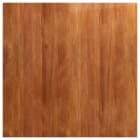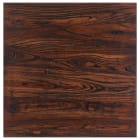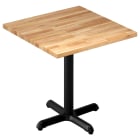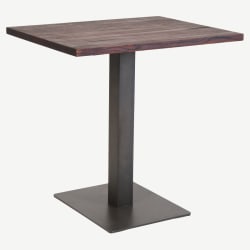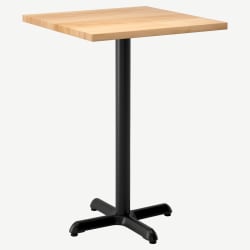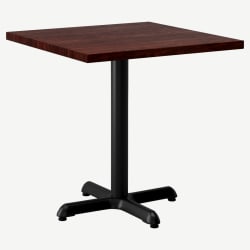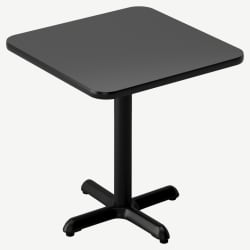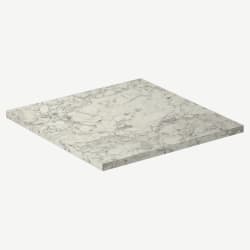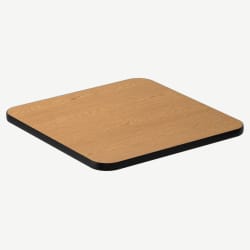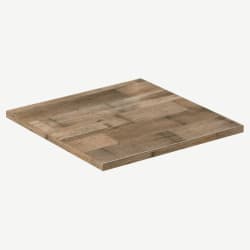Restaurant Tables
Popular Products
How to Choose the Right Tables for Your Venue
Choosing the right tables for your restaurant sounds a lot easier than it really is. Just ask any veteran restauranteur. When it comes to purchasing restaurant furniture, tables normally fall at the bottom of the shopping list.
While restaurant seating may be one of the first things people notice and see at your restaurant, tables can also make or break the way your dining room looks and how guests view your space. They are usually the focus of a restaurant and can be the accent that determines the ambiance.
Venue Size and Desired Seating Capacity
You may already have an idea of what type of restaurant table you like to have but do you have enough space to fit 10 or more of them in? While there is no thumb rule when it comes to selecting the right kind of tables, there are a few things you should consider:
- Selecting the right sized tables based on your available restaurant space.
- Never compromise on quality of materials you opt for – they should meet commercial industry standards. Restaurants see a lot of traffic so sturdy and long-lasting tables are important.
- The table surface should be large enough to accommodate the food you serve at your restaurant. For example, smaller table surfaces would work in a fast-food restaurant whereas a fine dining establishment would require a larger surface to accommodate the elaborate setting.
- Materials selected for your table should be easy to clean, maintain, appealing and durable. Tables for outdoor settings should be weatherproof.
- The standard height for a regular table can measure between 28” to 30” high. Bar tables stand at least 42” in heigth.
Materials
A restaurant table’s construction relies on a variety of materials. Some tables may have a holistic design whereas others use different designs and materials for the table top and table base. Below are some of the most used materials for designing restaurant tables:
- Solid wood – This material is the most popular option for restaurant table tops. Wood is a versatile construction material. It can be hardwood, softwood, or composite wood. Hardwood is commonly used for commercially built tables for its attractiveness and longevity. Common hardwoods include mahogany, oak, maple, walnut, cherry, etc.
- Metal – Metal tables are known for their durability and sturdiness. A metal tabletop is stain resistant, modern and cool to touch. If your restaurant dining space is contemporary or industrial, a metal restaurant table may be a great fit.
- Laminate – A laminate table top fits different budgets and styles. Each have different layers of materials that include PVC, high impact melamine, and some wood grain finishes. This material is also very sturdy and durable.
- Synthetic teak – Made to resemble the organic look of teak wood, this material is lightweight, low maintenance, durable, easy to clean, weatherproof and less expensive. As such, there is an increasing trend of synthetic teak dining tables for both indoor and outdoor commercial spaces.
- Granite/Stone - A granite or any other stone-based table top escalates your restaurant to another level. Granite table tops make everything look refined and therefore more appealing. Typically, granite or stone costs twice as much as hardwood tables. While this is a more expensive material, prices vary too depending on the type of stone used.
Shapes
The shape of your restaurant dining table may depend on the space available or your preference. Dining tables come in a range of shapes. Most popular shapes include:
- Rectangular – most popular shape and good as a divider in open spaces or hosting large groups of people.
- Square – currently trending and good for square areas and maximizing seating space.
- Round – old fashioned but very cozy. Most space- efficient option and facilitate conversation between patrons.
Style
Style is an important consideration since it makes a personal statement about your restaurant. Restaurant table styles include:
- Traditional
- Rustic Modern
- Industrial
- Contemporary
- Communal
- Folding
- And more
Choose a style that creates your intended ambiance and rhymes with your other furniture and design.
Frequently Asked Questions
How Much Space Should be Between Restaurant Tables?
When designing or refurbishing a restaurant layout, table spacing should be one of your first considerations. Although there are exceptions based on the table top shape, the ideal spacing requirements between each table is at least 24 to 30 inches apart.
What Table Top Size do I Need?
Below are a few examples to give you some idea:
- 2 Person: 24" round; 24" x 24" square; 24" x 30" rectangular.
- 4 Persons: minimum sizes range from 30" x 30" square to 36" round and 24" x 48" rectangle.
- 6-8 Person: minimum sizes range from 42" x 42" square to 48" round and 30" x 60" rectangle.
Note: Since parties of 8 or more diners are less common we recommend a drop leaf table or combining several tables together as needs arise.

